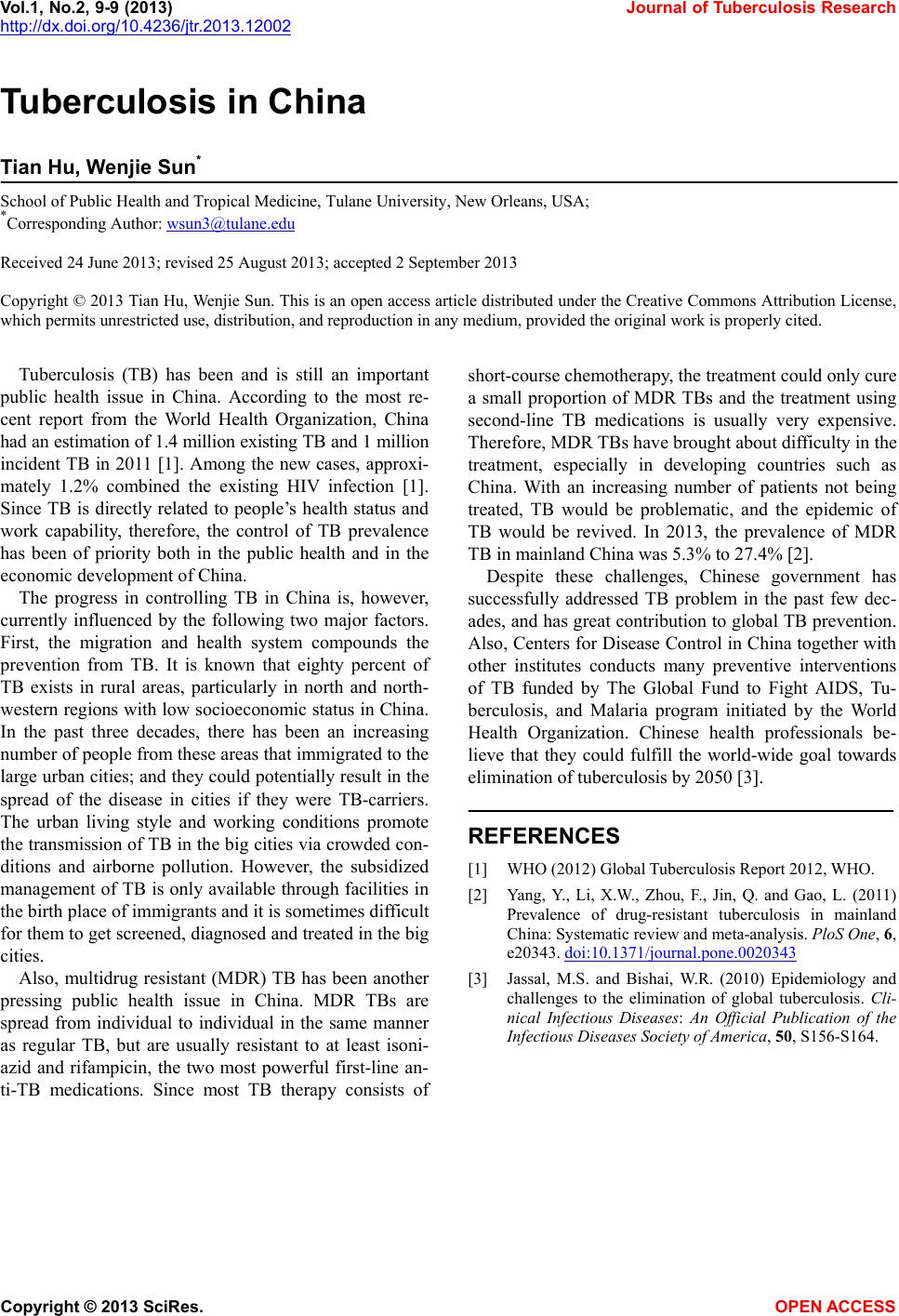
Vol.1, No.2, 9-9 (2013) Journal of Tubercu losis Research
http://dx.doi.org/10.4236/jtr.2013.12002
Tuberculosis in China
Tian Hu, Wenjie Sun*
School of Public Health and Tropical Medicine, Tulane University, New Orleans, USA;
*Corresponding Author: wsun3@tulane.edu
Received 24 June 2013; revised 25 August 2013; accepted 2 September 2013
Copyright © 2013 Tian Hu, Wenjie Sun. This is an open access article distributed under the Creative Commons Attribution License,
which permits unrestricted use, distribution, and reproduction in any medium, provided the original work is properly cited.
Tuberculosis (TB) has been and is still an important
public health issue in China. According to the most re-
cent report from the World Health Organization, China
had an estimation of 1.4 million existing TB and 1 million
incident TB in 2011 [1]. Among the new cases, approxi-
mately 1.2% combined the existing HIV infection [1].
Since TB is directly related to people’s health status and
work capability, therefore, the control of TB prevalence
has been of priority both in the public health and in the
economic development of China.
The progress in controlling TB in China is, however,
currently influenced by the following two major factors.
First, the migration and health system compounds the
prevention from TB. It is known that eighty percent of
TB exists in rural areas, particularly in north and north-
western regions with low socioeconomic status in China.
In the past three decades, there has been an increasing
number of people from these areas that immigrated to the
large urban cities; and they could potentially result in the
spread of the disease in cities if they were TB-carriers.
The urban living style and working conditions promote
the transmission of TB in the big cities via crowded con-
ditions and airborne pollution. However, the subsidized
management of TB is only available through facilities in
the birth place of immigrants and it is sometimes difficult
for them to get screened, diagnosed and treated in the big
cities.
Also, multidrug resistant (MDR) TB has been another
pressing public health issue in China. MDR TBs are
spread from individual to individual in the same manner
as regular TB, but are usually resistant to at least isoni-
azid and rifampicin, the two most powerful first-line an-
ti-TB medications. Since most TB therapy consists of
short-course chemotherapy, the treatment could only cure
a small proportion of MDR TBs and the treatment using
second-line TB medications is usually very expensive.
Therefore, MDR TBs have brought about difficulty in the
treatment, especially in developing countries such as
China. With an increasing number of patients not being
treated, TB would be problematic, and the epidemic of
TB would be revived. In 2013, the prevalence of MDR
TB in mainland China was 5.3% to 27.4% [2].
Despite these challenges, Chinese government has
successfully addressed TB problem in the past few dec-
ades, and has great contribution to global TB prevention.
Also, Centers for Disease Control in China together with
other institutes conducts many preventive interventions
of TB funded by The Global Fund to Fight AIDS, Tu-
berculosis, and Malaria program initiated by the World
Health Organization. Chinese health professionals be-
lieve that they could fulfill the world-wide goal towards
eliminati on of t uberculosis by 2050 [3] .
REFERENCES
[1] WHO (2012) Global Tuberculosis Report 2012, WHO.
[2] Yang, Y., Li, X.W., Zhou, F., Jin, Q. and Gao, L. (2011)
Prevalence of drug-resistant tuberculosis in mainland
China: Systematic review and meta-analysis. PloS One, 6,
e20343. doi:10.1371/journal.pone.0020343
[3] Jassal, M.S. and Bishai, W.R. (2010) Epidemiology and
challenges to the elimination of global tuberculosis. Cli-
nical Infectious Diseases: An Official Publication of the
Infectious Diseases Society of America, 50, S156-S164.
Copyright © 2013 SciRes. OPEN A CCESS